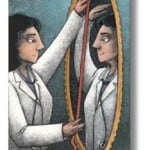We read in the Torah portion of the spiritual affliction called Tzaraat . Through the ages this affliction has been translated as the Leprosy we know of today which is known as Hansen’s disease. Yet the Tzaraat of the Bible was in fact not a physical disease at all. Rather it was a physical manifestation of a spiritual malaise.
“Hashem said to Moshe and Aaron, “When anyone has a swelling or a rash or a bright spot on his skin that may become an infectious skin disease, he must be brought to Aaron the priest or to one of his sons who is a priest. When the priest examines him, he shall pronounce him Tameh (ceremonially unclean).” (Leviticus 13:1)
It was not the physician that made the determination of the “disease” but rather the Kohen( priest). Furthermore it was declaration of the priest that actually brought about that state of Tumah or ritual impurity. This is especially obvious when we read the description of the contamination of a house;
“and the one to whom the house belongs comes and tells the Kohen, saying, “Something like a lesion has appeared to me in the house,” the Kohen shall order that they clear out the house, before the Kohen comes to look at the lesion, so that everything in the house should not become unclean. After this, the Kohen shall come to look at the house.(Leviticus 14: 35-36).
Why would the Kohen tell the people to take the items out of the house if it may be determined that the house was in fact Tameh. Obviously it only becomes Tameh after it was declared to be so by the Kohen. Clearly again the state of Tumah is not a function of what we call “reality” but is rather a fragment of a spiritual state of being. That is to say that the spiritual result and implication only manifest themselves upon the declaration of the Kohen who is representing Divine justice.
The word, Metzorah, the leprous one, is linked to the words Motzi Ra (brings out evil ) The malady is connected to the sin of Motzi Shem Ra (He who speaks slander of another). G-d has given mankind the power of speech. It is that power that separates mankind from all other creation. It is the same power that G-d used to create the world. Our abuse of it, on the other hand, can do the opposite and destroy worlds. They become weapons to destroy the character and spirit of the other. That inner corruption of a soul that separates one from his holy essence and most importantly from his people, results in the spiritual eruption of the Tzaraat.
It is important to note that the verse “And the Kohen shall see the affliction” “(Leviticus 13:3), unveils another level of understanding regarding the spiritual malady of slander and evil words.
Although the physical description of this affliction was clear to all in the revealed words of the text, the afflicted individual cannot make that determination. It necessitated him to call for the scrutiny of the Kohen.
Our sages highlighted an important aspect of this phenomenon.
“A person sees the afflictions of all, except his own” (Mishna Negaim 2:5).
We are always very quick to see the faults in the other and are quick to uncover the failures of those around us. Yet it is very difficult to see those same faults in ourselves.
The Baal Shem Tov taught that one who sees “bad” in another person, is usually because he is looking at a mirror and sees a whisper of his own failings. That perhaps may explain the haste and the ease by which we give ourselves the permission to criticize and lambast those around us.
This then explains the need for another set of eyes. It also explains the cure.
The “metzora” is made to live alone outside the camp (Leviticus 13:46). That is to say that in order to ameliorate that self-defeating tendency and bring about repentance and purification the Torah tells us that the metzora must dwell alone, “outside the Israelite camp.” (ibid) .This enforced exile and solitude symbolizes both the metzora’s self-imposed separation from his own divine purpose and from his connection to his fellow Jews.
On the other hand, it is in the solitude of exile that the arrogant heart is softened. It is in the banishment and the loneliness that the sparks of the truly repentant heart can ignite and blossom into a true expression of teshuva/ repentance.
Yet on a deeper level Reb Nachman teaches that if you actually look for the positive, holy, spark in those around you, that will release a deep awareness of the positive and holy in yourself. As a corollary if you are eager to change somebody else, it would be more fruitful to spend more effort on changing yourself.
These are the lessons of the exile of the Metzora and its ultimate purpose is the bringing back together all those who strive to be Hashem’s language in this world.
LeRefuat Yehudit bat Golda Yocheved

